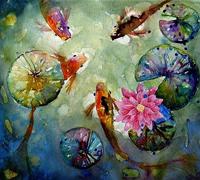| |
 Born in Brooklyn, New York, I currently reside in Natick, Massachusetts where I focus my time on establishing and supporting fundraising events through my art. My interests in both biology and environmental science, led me to a biology degree at Cornell University before continuing my graduate studies in Natural Resources at the University of Michigan. Two careers later (one in environmental mitigation focused on protecting natural and visual resources and one in fisheries biology), I received a M.Ed. at Lesley University and finally brought my love of art into the foreground when combined with the many facets of elementary education.
Born in Brooklyn, New York, I currently reside in Natick, Massachusetts where I focus my time on establishing and supporting fundraising events through my art. My interests in both biology and environmental science, led me to a biology degree at Cornell University before continuing my graduate studies in Natural Resources at the University of Michigan. Two careers later (one in environmental mitigation focused on protecting natural and visual resources and one in fisheries biology), I received a M.Ed. at Lesley University and finally brought my love of art into the foreground when combined with the many facets of elementary education.
Much of my work is done on the printing press creating one-of-a-kind monotypes using both water-based and oil mediums. My style is varied and ranges from representational images to abstract design. Vivid colors and authentic cultural patterns infuse my works. An avid traveler, the beauty of the natural world is a constant inspiration ~ from the lavender fields of France to the poppy blooms in Arizona.
My watercolors focus primarily on the watery world of koi. Having worked in a fisheries lab throughout graduate school gave me a healthy regard for the simple magnificence and curvilinear beauty of fish. Many of the paints I use are ground from semiprecious stones such as Lapis, Turquoise, Hematite, Jade, and Tourmaline which impart a vibrant and lustrous luminosity.
Currently, my works are exhibited in galleries throughout Boston’s Metrowest communities, Martha's Vineyard, Rhode Island, and New York. My paintings are held in private and corporate collections from the West to East coasts, Canada, Australia, Europe, Russia, and India. Collections are carried locally at Boston Children's Hospital, Floating Hospital for Children, Massachusetts General Hospital, and TJX Corporation.
Thanks for sharing your time in these pages and enjoy…
What is a Monotype? A monotype is a one-of-a-kind pulled impression that is created by painting on a plexiglass plate. The image is crafted through applications of ink that are rolled, brushed, and otherwise applied to the plate. Paper overlain on the plate is then “pulled” through a printing press thus creating a unique image. Monotypes are inherently unique because only one or two images may be pulled before the ink is used up (and unlike a plate that is etched, the plate cannot be re-inked to get another copy). Although there may be a second impression, it is quite different from the first in that most of the ink is now gone. The second impression, or ghost, is much lighter and is a faint representation of the first darker image. Each print is a finished work that is then either worked on with colored pencils, pastels, oil glazes, or collage materials.
What is a Gicleé? A giclée is an archival fine art reproduction in which the image is captured, proofed, printed digitally and produced as a limited edition. The giclée process begins after a transparency is produced for the original painting or the painting is scanned directly. The computer’s calculations of the properties of the scanned image, such as hue and density, control the ink spray. A print is made, often involving a color correction process between the artist and printmaker. The giclée process allows a print to have a higher resolution than a lithograph and a very high range of color. Every nuance of the original is captured using extremely colorfast inks that have non-fading properties (up to 200 years in normal lighting conditions), reproduced on acid-free, archival paper.
Thanks for browsing.
|